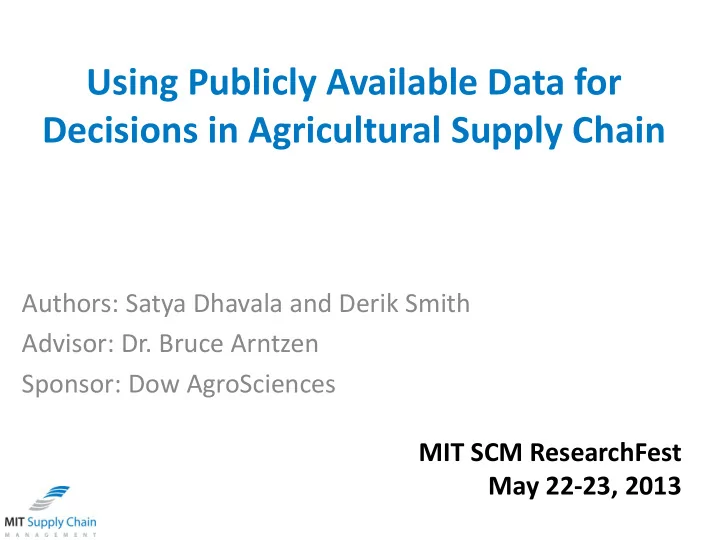

Using Publicly Available Data for Decisions in Agricultural Supply Chain Authors: Satya Dhavala and Derik Smith Advisor: Dr. Bruce Arntzen Sponsor: Dow AgroSciences MIT SCM ResearchFest May 22-23, 2013
Agenda • Key Question • Introduction • Methodology • Results • Conclusion May 22-23, 2013 MIT SCM ResearchFest 2
Key Question • How can a manufacturer of agricultural chemicals use the variety of available data to improve its forecasts and supply chain decisions? May 22-23, 2013 MIT SCM ResearchFest 3
Data in Agriculture • Data Types • Crop projections and actuals • Yield projections and actuals • Weather forecasts and reports • Data Sources • United States Department of Agriculture (USDA) • Universities – Land-grant and others • Meteorological agencies • Applications of Data • Macro economic forecasting • Environmental and sustainability related decisions • Decisions by growers on various aspects of farming May 22-23, 2013 MIT SCM ResearchFest 4
Ag. Chemical Distribution Chain • Finite manufacturing capacity • Long production and distribution lead times • Production is based on forecasts and occurs month in advance of a short, uncertain sales season • Many factors influence demand May 22-23, 2013 MIT SCM ResearchFest 5
AgChem • A crop chemical predominantly used on corn • Two possible application windows – fall and spring • Choice of AgChem for this study • Sales have increased significantly in recent years May 22-23, 2013 MIT SCM ResearchFest 6
AgChem - Application Windows • Sales occur ahead of the growing season Sales Season Crop cycle Crop cycle Fall Spring May 22-23, 2013 MIT SCM ResearchFest 7
Methodology • Identify and analyze the factors • Structure the problem • Gather data for each factor • Develop models (regression) and test significance of each factor • Eliminate insignificant factors and fine-tune significant factors for better accuracy May 22-23, 2013 MIT SCM ResearchFest 8
Factors Analyzed • • No relevant Corn price Corn acres planted variables • • Fertilizer usage Corn acres harvested • • Corn acres planted Average yield • • Annual Corn acres harvested Increase in yield • • Average yield Number of retailers Time • • Fertilizer price Bulk storage capacity Dimension • AgChem price • No relevant variables No relevant variables Temperature • Weekly Precipitation • Sales to date National County City Geographical Dimension May 22-23, 2013 MIT SCM ResearchFest 9
Structuring the Problem • Some of the factors are leading indicators and some are lagging • Factors differ by the way they influence demand and their granularity • Divide the problem • Annual, nation-wide demand • Annual, county-level demand • Short-term, city-level demand May 22-23, 2013 MIT SCM ResearchFest 10
Results: Annual, Nation-wide May 22-23, 2013 MIT SCM ResearchFest 11
Results: Annual, county-level demand • Significant factors for annual, county-level demand • Corn acres harvested • Number of local retailers • AgChem sales in the first few weeks of the season May 22-23, 2013 MIT SCM ResearchFest 12
Additional Findings 2008-2009 2010-2011 2009 - 2010 2007 – 2008 May 22-23, 2013 MIT SCM ResearchFest 13
Results: Short-term, city-level demand • Harvest completion date acts as a trigger point for fall sales • Average temperature is the only significant factor Sales volume by week Harvest completion May 22-23, 2013 MIT SCM ResearchFest 14
Conclusion • Implications for DAS • Better understand the external factors • Fine-tune existing forecasting models • Position inventory more effectively by tracking trends such as harvest completion • Limitations and scope for further research • Retailer city was used instead of application city, for short-term model • Temperature and precipitation were used based on the nearest weather station • Period we analyzed experienced only an upward trend in volumes May 22-23, 2013 MIT SCM ResearchFest 15
May 22-23, 2013 MIT SCM ResearchFest 16
Recommend
More recommend